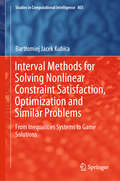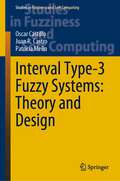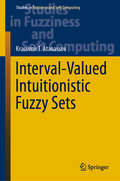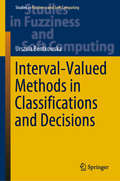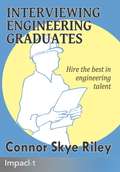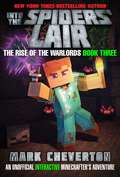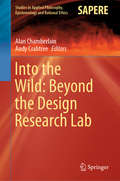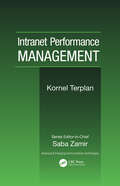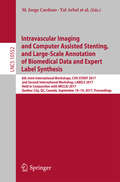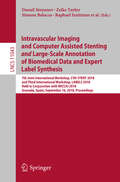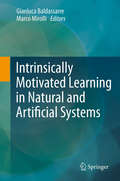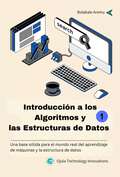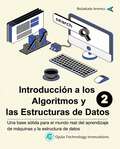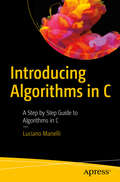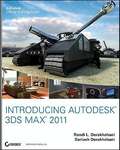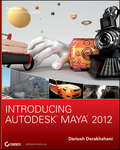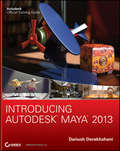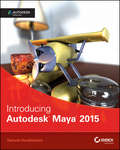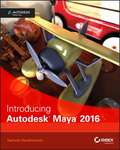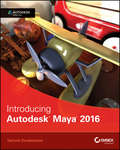- Table View
- List View
Intertwining Graphonomics with Human Movements: 20th International Conference of the International Graphonomics Society, IGS 2021, Las Palmas de Gran Canaria, Spain, June 7-9, 2022, Proceedings (Lecture Notes in Computer Science #13424)
by Aythami Morales Cristina Carmona-Duarte Moises Diaz Miguel A. FerrerThis book constitutes the proceedings of the 20th International Conference of the International Graphonomics Society, IGS 2021/2022. Originally planned to be celebrated in September 2021, due to the COVID-19 pandemic it was held in June 2022.The 36 full and 3 short papers presented at the conference were carefully reviewed and selected from 41 submissions and reviewed by a committee of 67 reviewers. Out of the 41 conferences, 26 papers were selected to be published in this proceedings. The program was comprised of 6 oral sessions on the following topics: historical documents, forensic handwriting examinations, handwriting learning and development, and motor control. One additional poster session included papers on all previous topics, and three special sessions included papers on neurodegenerative disorders.
Interval Methods for Solving Nonlinear Constraint Satisfaction, Optimization and Similar Problems: From Inequalities Systems to Game Solutions (Studies in Computational Intelligence #805)
by Bartłomiej Jacek KubicaThis book highlights recent research on interval methods for solving nonlinear constraint satisfaction, optimization and similar problems. Further, it presents a comprehensive survey of applications in various branches of robotics, artificial intelligence systems, economics, control theory, dynamical systems theory, and others. Three appendices, on the notation, representation of numbers used as intervals’ endpoints, and sample implementations of the interval data type in several programming languages, round out the coverage.
Interval Type-3 Fuzzy Systems: Theory and Design (Studies in Fuzziness and Soft Computing #418)
by Oscar Castillo Juan R. Castro Patricia MelinThis book briefly reviews the basic concepts of type-2 fuzzy systems and then describes the proposed definitions for interval type-3 fuzzy sets and relations, also interval type-3 inference and systems. The use of type-2 fuzzy systems has become widespread in the leading economy sectors, especially in industrial and application areas, such as services, health, defense, and so on. However, recently the use of interval type-3 fuzzy systems has been receiving increasing attention and some successful applications have been developed in the last year. These issues were taken into consideration for this book, as we did realize that there was a need to offer the main theoretical concepts of type-3 fuzzy logic, as well as methods to design, develop and implement the type-3 fuzzy systems. A review of basic concepts and their use in the design and implementation of interval type-3 fuzzy systems, which are relatively new models of uncertainty and imprecision, are presented. The main focus of this work is based on the basic reasons of the need for interval type-3 fuzzy systems in different areas of application. In addition, we describe methods for designing interval type-3 fuzzy systems and illustrate this with some examples and simulations.
Interval-Valued Intuitionistic Fuzzy Sets (Studies in Fuzziness and Soft Computing #388)
by Krassimir T. AtanassovThe book offers a comprehensive survey of interval-valued intuitionistic fuzzy sets. It reports on cutting-edge research carried out by the founder of the intuitionistic fuzzy sets, Prof. Krassimir Atanassov, giving a special emphasis to the practical applications of this extension. A few interesting case studies, such as in the area of data mining, decision making and pattern recognition, among others, are discussed in detail.The book offers the first comprehensive guide on interval-valued intuitionistic fuzzy sets. By providing the readers with a thorough survey and important practical details, it is expected to support them in carrying out applied research and to encourage them to test the theory behind the sets for new advanced applications. The book is a valuable reference resource for graduate students and researchers alike.
Interval-Valued Methods in Classifications and Decisions (Studies in Fuzziness and Soft Computing #378)
by Urszula BentkowskaThis book describes novel algorithms based on interval-valued fuzzy methods that are expected to improve classification and decision-making processes under incomplete or imprecise information. At first, it introduces interval-valued fuzzy sets. It then discusses new methods for aggregation on interval-valued settings, and the most common properties of interval-valued aggregation operators. It then presents applications such as decision making using interval-valued aggregation, and classification in case of missing values. Interesting applications of the developed algorithms to DNA microarray analysis and in medical decision support systems are shown. The book is intended not only as a timely report for the community working on fuzzy sets and their extensions but also for researchers and practitioners dealing with the problems of uncertain or imperfect information.
Interviewing Engineering Graduates
by Connor Skye RileyA strong engineering team is the backbone of any technical company, and smart managers are always looking to hire top talent. Recruiting and interviewing engineers in a smart way is essential to the growth of your team and your company. In this saturated hiring market, your positions must stand out among the big name companies, and your hiring processes must be rigorous, fair and efficient. This comprehensive guide will show you how to hire outstanding technical employees. With its step-by-step instructions and examples, Interviewing Engineering Graduates will take you all the way through the process, from attracting great candidates to making hiring decisions with confidence. Hiring engineers is a complex, expensive and crucial process. This book will get you organized quickly and prepare you to make the right decisions every step of the way. First, you’ll see how to market your open jobs effectively through writing amazing job descriptions, and selling your company to top engineers so that you get the best applicants. You’ll then learn to narrow the field by identifying the best resumes. Using our tips, tricks and templates, you can design, plan and prepare thoroughly for smooth running, multi-stage assessments and interviews. Finally, you’ll easily identify which engineers will be top performers for your company, get your whole team involved in the hiring decision, and clinch that final offer! Whatever your company and whatever type of engineering job you’re hiring for, with this book you can hire employees with the technical savvy and teamwork skills to help take your organization to the next level.
Interviewing Users
by Steve PortigalInterviewing is a foundational user research tool that people assume they already possess. Everyone can ask questions, right? Unfortunately, that's not the case. Interviewing Users provides invaluable interviewing techniques and tools that enable you to conduct informative interviews with anyone. You'll move from simply gathering data to uncovering powerful insights about people.
Intimacy on the Internet: Media Representations of Online Connections (Routledge Research in Cultural and Media Studies)
by Lauren RosewarneThe focus of this book is on the media representations of the use of the Internet in seeking intimate connections—be it a committed relationship, a hook-up, or a community in which to dabble in fringe sexual practices. Popular culture (film, narrative television, the news media, and advertising) present two very distinct pictures of the use of the Internet as related to intimacy. From news reports about victims of online dating, to the presentation of the desperate and dateless, the perverts and the deviants, a distinct frame for the intimacy/Internet connection is negativity. In some examples however, a changing picture is emerging. The ubiquitousness of Internet use today has meant a slow increase in comparatively more positive representations of successful online romances in the news, resulting in more positive-spin advertising and a more even-handed presence of such liaisons in narrative television and film. Both the positive and the negative media representations are categorised and analysed in this book to explore what they reveal about the intersection of gender, sexuality, technology and the changing mores regarding intimacy.
Into the Spiders' Lair: The Rise of the Warlords Book Three: An Unofficial Minecrafter's Adventure (Rise of the Warlords #3)
by Mark ChevertonThe witches of the Far Lands of Minecraft are missing . . . all of them! When a young village girl is badly injured, and only a witch can help her, Watcher and his friends quickly discover there are spiders involved. They must follow clues leading them through jungles and forests, all the way to the doorstep of the dreaded outcast spiders, the Forgotten. Watcher and his companions must figure out a way to free the witches from their ruthless captors, but can they escape the Lair of the Forgotten in time to save the girl?The Rise of the Warlords series is a Minecraft adventure like never before, giving fans the option to play along in Minecraft as they read on custom Far Lands worlds exclusively designed by bestselling author Mark Cheverton.
Into the Wild: Beyond the Design Research Lab (Studies in Applied Philosophy, Epistemology and Rational Ethics #48)
by Alan Chamberlain Andy CrabtreeThis edited collection opens up new intellectual territories and articulates the ways in which academics are theorising and practicing new forms of research in ‘wild’ contexts. Many researchers are choosing to leave the familiarity of their laboratory-based settings in order to pursue in-situ studies ‘in the wild’ that can help them to better understand the implications of their work in real-world settings. This has naturally led to ethical, philosophical and practical reappraisals with regard to the taken for granted lab-based modus operandi of scientific, cultural and design-based ways of working. This evolving movement has led to a series of critical debates opening up around the nature of research in the wild, but up until now these debates have not been drawn together in a coherent way that could be useful in an academic context. The book brings together applied, methodological and theoretical perspectives relating to this subject area, and provides a platform and a source of reference material for researchers, students and academics to base their work on. Cutting across multiple disciplines relating to philosophy, sociology, ethnography, design, human–computer interaction, science, history and critical theory, this timely collection appeals to a broad range of academics in varying fields of research.
Intranet Performance Management (Advanced And Emerging Communications Technologies Ser. #7)
by Kornel TerplanTo avoid serious bottlenecks, components of the Internet and of intranets-such as servers, browsers, and the access networks-must be properly designed, implemented, managed, and monitored. Beginning with the basics, Intranet Performance Management sets forth the standards, methods, and tools that can simplify and unify systems and network management, avoid the seemingly inherent problems associated with them, and contain costs.In this book, world reknowned expert Kornel Terplan addresses: Proactive server, browser, and access network monitoring Managing and authoring home page content Traffic management and load balancing in the access networks Reviewing and evaluating usage statistics using log filesThese tasks-essential to the success of an intranet-require the active and diligent work of the management team. Effective performance of these tasks allows for the use of inexpensive browsers, facilitates education, and improves Internet culture and scalability.
Intravascular Imaging and Computer Assisted Stenting, and Large-Scale Annotation of Biomedical Data and Expert Label Synthesis
by M. Jorge Cardoso Tal Arbel Su-Lin Lee Veronika Cheplygina Simone Balocco Diana Mateus Guillaume Zahnd Lena Maier-Hein Stefanie Demirci Eric Granger Luc Duong Marc-André Carbonneau Shadi Albarqouni Gustavo CarneiroThis book constitutes the refereed joint proceedings of the 6th Joint International Workshop on Computing and Visualization for Intravascular Imaging and Computer Assisted Stenting, CVII-STENT 2017, and the Second International Workshop on Large-Scale Annotation of Biomedical Data and Expert Label Synthesis, LABELS 2017, held in conjunction with the 20th International Conference on Medical Imaging and Computer-Assisted Intervention, MICCAI 2017, in Québec City, QC, Canada, in September 2017. The 6 full papers presented at CVII-STENT 2017 and the 11 full papers presented at LABELS 2017 were carefully reviewed and selected. The CVII-STENT papers feature the state of the art in imaging, treatment, and computer-assisted intervention in the field of endovascular interventions. The LABELS papers present a variety of approaches for dealing with few labels, from transfer learning to crowdsourcing.
Intravascular Imaging and Computer Assisted Stenting and Large-Scale Annotation of Biomedical Data and Expert Label Synthesis: 7th Joint International Workshop, CVII-STENT 2018 and Third International Workshop, LABELS 2018, Held in Conjunction with MICCAI 2018, Granada, Spain, September 16, 2018, Proceedings (Lecture Notes in Computer Science #11043)
by Pierre Jannin Eric Granger Emanuele Trucco Diana Mateus Veronika Cheplygina Stefano Moriconi Su-Lin Lee Shadi Albarqouni Stefanie Demirci Guillaume Zahnd Luc Duong Lena Maier-Hein Anne Martel Raphael Sznitman Simone Balocco Zeike Taylor Danail StoyanovThis book constitutes the refereed joint proceedings of the 7th Joint International Workshop on Computing and Visualization for Intravascular Imaging and Computer Assisted Stenting, CVII-STENT 2018, and the Third International Workshop on Large-Scale Annotation of Biomedical Data and Expert Label Synthesis, LABELS 2018, held in conjunction with the 21th International Conference on Medical Imaging and Computer-Assisted Intervention, MICCAI 2018, in Granada, Spain, in September 2018. The 9 full papers presented at CVII-STENT 2017 and the 12 full papers presented at LABELS 2017 were carefully reviewed and selected. The CVII-STENT papers feature the state of the art in imaging, treatment, and computer-assisted intervention in the field of endovascular interventions. The LABELS papers present a variety of approaches for dealing with few labels, from transfer learning to crowdsourcing.
Intrinsically Motivated Learning in Natural and Artificial Systems
by Gianluca Baldassarre Marco MirolliIt has become clear to researchers in robotics and adaptive behaviour that current approaches are yielding systems with limited autonomy and capacity for self-improvement. To learn autonomously and in a cumulative fashion is one of the hallmarks of intelligence, and we know that higher mammals engage in exploratory activities that are not directed to pursue goals of immediate relevance for survival and reproduction but are instead driven by intrinsic motivations such as curiosity, interest in novel stimuli or surprising events, and interest in learning new behaviours. The adaptive value of such intrinsically motivated activities lies in the fact that they allow the cumulative acquisition of knowledge and skills that can be used later to accomplish fitness-enhancing goals. Intrinsic motivations continue during adulthood, and in humans they underlie lifelong learning, artistic creativity, and scientific discovery, while they are also the basis for processes that strongly affect human well-being, such as the sense of competence, self-determination, and self-esteem.This book has two aims: to present the state of the art in research on intrinsically motivated learning, and to identify the related scientific and technological open challenges and most promising research directions. The book introduces the concept of intrinsic motivation in artificial systems, reviews the relevant literature, offers insights from the neural and behavioural sciences, and presents novel tools for research. The book is organized into six parts: the chapters in Part I give general overviews on the concept of intrinsic motivations, their function, and possible mechanisms for implementing them; Parts II, III, and IV focus on three classes of intrinsic motivation mechanisms, those based on predictors, on novelty, and on competence; Part V discusses mechanisms that are complementary to intrinsic motivations; and Part VI introduces tools and experimental frameworks for investigating intrinsic motivations.The contributing authors are among the pioneers carrying out fundamental work on this topic, drawn from related disciplines such as artificial intelligence, robotics, artificial life, evolution, machine learning, developmental psychology, cognitive science, and neuroscience. The book will be of value to graduate students and academic researchers in these domains, and to engineers engaged with the design of autonomous, adaptive robots.The contributing authors are among the pioneers carrying out fundamental work on this topic, drawn from related disciplines such as artificial intelligence, robotics, artificial life, evolution, machine learning, developmental psychology, cognitive science, and neuroscience. The book will be of value to graduate students and academic researchers in these domains, and to engineers engaged with the design of autonomous, adaptive robots.
Intrinsically Motivated Learning in Natural and Artificial Systems
by Marco Mirolli Gianluca BaldassarreIt has become clear to researchers in robotics and adaptive behaviour that current approaches are yielding systems with limited autonomy and capacity for self-improvement. To learn autonomously and in a cumulative fashion is one of the hallmarks of intelligence, and we know that higher mammals engage in exploratory activities that are not directed to pursue goals of immediate relevance for survival and reproduction but are instead driven by intrinsic motivations such as curiosity, interest in novel stimuli or surprising events, and interest in learning new behaviours. The adaptive value of such intrinsically motivated activities lies in the fact that they allow the cumulative acquisition of knowledge and skills that can be used later to accomplish fitness-enhancing goals. Intrinsic motivations continue during adulthood, and in humans they underlie lifelong learning, artistic creativity, and scientific discovery, while they are also the basis for processes that strongly affect human well-being, such as the sense of competence, self-determination, and self-esteem. This book has two aims: to present the state of the art in research on intrinsically motivated learning, and to identify the related scientific and technological open challenges and most promising research directions. The book introduces the concept of intrinsic motivation in artificial systems, reviews the relevant literature, offers insights from the neural and behavioural sciences, and presents novel tools for research. The book is organized into six parts: the chapters in Part I give general overviews on the concept of intrinsic motivations, their function, and possible mechanisms for implementing them; Parts II, III, and IV focus on three classes of intrinsic motivation mechanisms, those based on predictors, on novelty, and on competence; Part V discusses mechanisms that are complementary to intrinsic motivations; and Part VI introduces tools and experimental frameworks for investigating intrinsic motivations.The contributing authors are among the pioneers carrying out fundamental work on this topic, drawn from related disciplines such as artificial intelligence, robotics, artificial life, evolution, machine learning, developmental psychology, cognitive science, and neuroscience. The book will be of value to graduate students and academic researchers in these domains, and to engineers engaged with the design of autonomous, adaptive robots. The contributing authors are among the pioneers carrying out fundamental work on this topic, drawn from related disciplines such as artificial intelligence, robotics, artificial life, evolution, machine learning, developmental psychology, cognitive science, and neuroscience. The book will be of value to graduate students and academic researchers in these domains, and to engineers engaged with the design of autonomous, adaptive robots.
Introducción a los Algoritmos y las Estructuras de Datos 1: Una base sólida para el mundo real del aprendizaje de máquinas y la estructura de datos (Introducción a los Algoritmos y las Estructuras de Datos #1)
by Bolakale AremuBeneficios acerca del aprendizaje de algoritmos y estructuras de datos. Primero, te ayudarán a convertirte en un mejor programador. Otro beneficio es que te harán pensar más lógicamente. Además, te pueden ayudar a diseñar mejores sistemas para almacenar y procesar datos. También sirven como una herramienta para la optimización y solución de problemas. Como resultado, los conceptos de algoritmos y estructuras de datos son muy valiosos en cualquier campo. Por ejemplo, puedes utilizarlos cuando construyas una aplicación web o escribes software para otros dispositivos. Puedes utilizarlos para aprendizaje de máquinas y analíticas de datos, las cuales son actualmente dos áreas excitantes. Si eres un hacker, los algoritmos y las estructuras de datos en Python también son importantes para ti en cualquier parte. Ahora, cualquiera que sea tu estilo de aprendizaje preferido, te tendré cubierto. Si eres un aprendiz visual, te encantarán mis diagramas claros e ilustraciones a través de este libro. Si eres un aprendiz práctico, te encantarán mis lecciones de práctica, de manera que puedas obtener práctica con algoritmos y estructuras de datos de una forma práctica. Estructura del curso. Hay cinco volúmenes en este curso. Este es el volumen uno. En este volumen, tomarás una inmersión profunda en el mundo de los algoritmos. Con frecuencia incremental, los algoritmos comienzan a moldear nuestras vidas de muchas maneras - desde los productos que nos recomiendan, hasta los amigos en que interactuamos en los medios sociales, y aún más importante que los aspectos sociales, como las políticas, privacía y cuidado de la salud. Por lo tanto, la primera parte de este curso cubre lo que son los algoritmos, como trabajan, donde se les puede encontrar (en aplicaciones de la vida real). En el segundo volumen, trabajarás a través de la introducción de las estructuras de datos. Aprenderás acerca de las e
Introducción a los Algoritmos y las Estructuras de Datos 2: Una base sólida para el mundo real del aprendizaje de máquinas y análisis de datos (Introducción a los Algoritmos y las Estructuras de Datos #2)
by Bolakale AremuIntroducción a Algoritmos y Estructuras de Datos - Volumen 2 Este libro es el segundo volumen de una serie titulada Introducción a los Algoritmos y Estructuras de Datos. El diseño de un algoritmo eficiente para la solución de problemas requiere la inclusión de las estructuras de datos apropiadas. En el campo de la ciencia de la computación, las estructuras de datos se utilizan para organizar y almacenar datos de una forma que sea más fácil de entender y utilizar. Se utilizan para organizar y representar datos de una forma que sea más fácil a las computadoras recuperar y analizar. Estos son los bloques de construcción fundamentales que cualquier programador debe conocer acerca de cómo utilizarlos correctamente para construir tus propios programas.
Introducing Algorithms in C: A Step by Step Guide to Algorithms in C
by Luciano ManelliStudy elementary and complex algorithms with clear examples and implementations in C. This book introduces data types (simple and structured) and algorithms with graphical and textual explanations. In the next sections, you’ll cover simple and complex standard algorithms with their flowcharts: everything is integrated with explanations and tables to give a step-by-step evolution of the algorithms. The main algorithms are: the sum of three or n numbers in a loop, decimal-to-binary conversion, maximum and minimum search, linear/sequential search, binary search, bubble sort, selection sort, merging of two sorted arrays, reading characters from a file, stack management, and factorial and Fibonacci sequences. The last section of Introducing Algorithms in C is devoted to the introduction of the C language and the implementation of the code, which is connected to the studied algorithms. The book is full of screenshots and illustrations showing the meaning of the code. What You Will Learn Implement algorithms in C Work with variables, constants, and primitive and structured types Use arrays, stacks, queues, graphs, trees, hash tables, records, and files Explore the design of algorithms Solve searching problems, including binary search, sorting, and bubble/selection sort Program recursive algorithms with factorial functions and Fibonacci sequences Who This Book Is For Primarily beginners: it can serve as a starting point for anyone who is beginning the study of computer science and information systems for the first time.
Introducing Autodesk 3ds Max 2011
by Dariush DerakhshaniAn Autodesk Official Training Guide to 3ds Max 2011 3ds Max is a popular 3D animation-and-effects software used in movies, visual effects, games, cartoons, short films, commercials, and other animation. However, it also presents a number of challenges to newcomers. This introduction to the latest version breaks down the complexities of learning 3D software and walks you through the basics of modeling, texturing, animating, and using visual effects. Real-world examples from talented beginning 3ds max users motivate you to learn the software and helpful tutorials offer realistic, professional challenges for you to unravel. In addition, each chapter is richly illustrated with workflows to make learning 3ds max 2011 much easier and fn. Introduces you to the basics of modeling, texturing, animating, and incorporating visual effects using the latest version of 3ds Max software Features excellent tutorials, helpful examples, detailed workflows, and a companion Web site to enhance your learning experience Explains a variety of methods for solving real-world challenges and breaks down why certain methods are used Makes the transition of coming from other 3D software applications as smooth as possible Introducing 3ds Max 2011 takes a typically difficult subject and breaks into easily digestible pieces so you can confidently begin working with this 3D animation software today.
Introducing Autodesk Maya 2012
by Dariush DerakhshaniA practical, step-by-step guide to Maya 2012 This book is the ideal primer to getting started with Maya, the premier 3D animation and effects software used in movies, visual effects, games, cartoons, short films, and commercials. You'll learn the Maya interface and the basics of modeling, texturing, animating, and visual effects. Professional visual effects artist and instructor Dariush Derakhshani explains the nuances of the complex software, while creative tutorials offer realistic, professional challenges for those new to 3D. You'll be up and running in no time with the world's most popular professional 3D software application. Provides a thorough, step-by-step introduction to Maya 2012 Explains the core concepts of CG and working in 3D Covers modeling, rigging, HDRI lighting, mental ray rendering, and more Concepts are reinforced with tutorials that offer realistic challenges and clear explanations Color insert provides real-world examples from talented beginning Maya users Build your Maya and animation skills from the ground up with this practical, thorough guide.
Introducing Autodesk Maya 2013
by Dariush DerakhshaniA complete update to the popular Autodesk Official Training Guide for Maya Maya is the industry-leading 3D animation and effects software used in movies, visual effects, games, cartoons, and other animation. This bestselling, official guide is a must for 3D beginners who want a thorough grounding in this dynamic and complex software. Fully updated for the newest version of Maya, the book explains the interface and the basics of modeling, texturing, animating, dynamics, visualization, and visual effects. Fun and challenging tutorials lead you through the nuances of the software and offer plenty of chances to practice what you've learned. The Autodesk Official Training Guide for Maya, endorsed and promoted by Autodesk to its 2,500 Authorized Training Centers worldwide Maya is the 3D animation and effects software used in the film, game, and advertising industries; it's a complex program and this book gives beginners the knowledge and confidence they need Shows how to master the interface and the basics of modeling, texturing, animating, and visual effects Step-by-step tutorials offer realistic, professional challenges for those new to 3D and those switching from another 3D application Materials are available for instructors who want to use this guide with their students Introducing Autodesk Maya is the perfect guide to get you up and running on the world's most popular professional 3D application.
Introducing Autodesk Maya 2015
by Dariush DerakhshaniLearn Autodesk Maya from an award-winning insider <P><P> Best-selling author, visual effects supervisor, and technical educator Dariush Derakhshani brings you a newly-updated, step-by-step guide to the most popular and complex 3D application on the market, Autodesk Maya. Introducing Autodesk Maya 2015 includes straightforward lessons, real-world examples, detailed tutorials, and downloadable project files that get you modeling and animating your own digital models and scenes right away.<P> The book starts you with the latest CG concepts and production workflows, and then shows you how to create a solar system to help get you acquainted with the basic tool set in Maya. From there, the books helps you: <P> * Learn the Maya user interface, including menus and plug-ins <P> * Build simple animations and 3D images right away <P> * Explore polygons, modeling, and NEX tools<P> * Get started with HDRI lighting, rendering, dynamics, simulations, and effects <P> Whether you're new to 3D or migrating from another 3D application, Introducing Autodesk Maya 2015 will kick-start your creativity and get you up and running with Maya. Author Derakhshani has worked on movies such as The Fantastic Four and Pan's Labyrinth, the South Park TV series, and numerous commercials and music videos.
Introducing Autodesk Maya 2016: Autodesk Official Press
by Dariush DerakhshaniStart modeling right away with this hands-on guide to learning Autodesk Maya 2016 Introducing Autodesk Maya 2016 is the official guide to the most popular and complex 3D application on the market. Building from the ground up, this book combines straightforward text with practical examples that make it easy to absorb the basics and start designing and animating your own digital models and scenes. The tutorials offer realistic challenges and clear explanations, laid out in fun, step-by-step lessons that help you gain confidence and learn by doing. You'll delve into CG and 3D core concepts and production workflows, then get right to work designing an animation of the solar system as you learn the interface and basic tools. As your modeling skills grow, you'll build a steam locomotive, a starfish, a table lamp, and much more as you learn to rig your model for animation, create fabric motion with nCloth, and add the lighting and effects that bring your scenes to life. The companion website features downloadable project files that help you see how the pros do it, and the book includes real-world examples from talented users who were beginners just like you. Master the Maya 2016 interface, menus, and plug-ins Begin building simple animations right away Explore modeling, rendering, animation, and cloth motion Add lighting, rendering, dynamics, simulations, and effects If you want to work like the pros, Introducing Autodesk Maya 2016 is the perfect primer for getting started.
Introducing Autodesk Maya 2016: Autodesk Official Press
by Dariush DerakhshaniStart modeling right away with this hands-on guide to learning Autodesk Maya 2016 Introducing Autodesk Maya 2016 is the official guide to the most popular and complex 3D application on the market. Building from the ground up, this book combines straightforward text with practical examples that make it easy to absorb the basics and start designing and animating your own digital models and scenes. The tutorials offer realistic challenges and clear explanations, laid out in fun, step-by-step lessons that help you gain confidence and learn by doing. You'll delve into CG and 3D core concepts and production workflows, then get right to work designing an animation of the solar system as you learn the interface and basic tools. As your modeling skills grow, you'll build a steam locomotive, a starfish, a table lamp, and much more as you learn to rig your model for animation, create fabric motion with nCloth, and add the lighting and effects that bring your scenes to life. The companion website features downloadable project files that help you see how the pros do it, and the book includes real-world examples from talented users who were beginners just like you. Master the Maya 2016 interface, menus, and plug-ins Begin building simple animations right away Explore modeling, rendering, animation, and cloth motion Add lighting, rendering, dynamics, simulations, and effects If you want to work like the pros, Introducing Autodesk Maya 2016 is the perfect primer for getting started.
Introducing Autodesk Revit Architecture 2012
by Patrick DavisA fast, focused introduction to Revit functions, tools, and concepts As the leading Building Information Modeling software package, Revit is praised for its ease of use, power, and sophistication. Authored by a high profile team of Revit professionals, this reference and tutorial quickly has readers building skills to an intermediate level by exploring Revit tools and tasks, putting parametric modeling to use, detailing the basics of views and constraints, and working with detailing, massing, rendering, interior design, and more. Based on real-world workflows and projects, this book shows you readers how to model, document, present, and share designs using Revit just the way the pros do. Discussions and workflows are reinforced with tutorials drawn from the authors' extensive experience, and a beautiful 16-page color insert focuses on real-world Revit projects. Helps novice-to-intermediate level users learn Revit and its functions, tools, and concepts easily and efficiently Contains straightforward explanations, real-world examples, beautiful illustrations, and practical tutorials that focus intently on accomplishing vital Revit tasks Features in-depth discussions reinforced by comprehensive step-by-step exercises that show you how to model, document, present, and share your designs Includes a beautiful 16-page color insert with inspirational and instructional images drawn from the authors' professional experience This book is the perfect resource for readers of all skill levels who want to quickly accomplish crucial Revit tasks.

